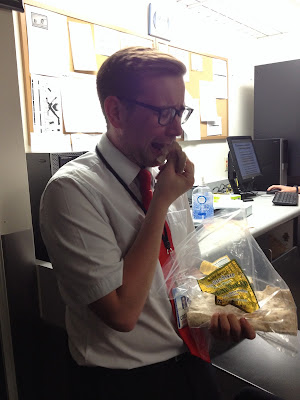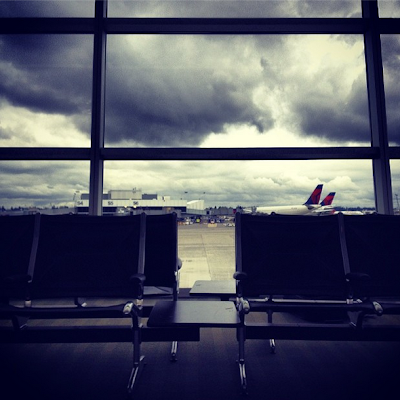Flight Hours.
Year Two. Month Seven. #SEA.
I've been working a lot.
And by a lot, I mean, a lot.
Lots of people ask me: how much do you work in a month? How many days off? How many nights away? How do you get paid, even?
The answer is complicated.
Airlines pay their cabin crew in a variety of ways. Most cabin crew are hourly. Rarely they are salaried, and these folks usually hold lead, instructor or administrative roles.
Hourly works a little different when your office in in the sky. For example, I am required to check in at the airport forty-five minutes prior to departure. This is a short check-in time, several of my long haul friend have to check in an hour to three hours prior to a big international flight.
Unlike the stamping of work time cards, checking in for a flight doesn't necessarily start the work clock. Instead, our per diem clock is started, which will run until the end of our full trip, once we leave the airport for the final time and head to our cars in the employee lot.
 |
| Me after a long four-day trip, back in my car, ready to go home. |
Per diem isn't hourly pay... well, actually it is. It ranges from a dollar or two an hour upwards to the double digits, depending on the airline and whether the trip is international or not. This per diem is usually not taxed, and is considered cash for every day expenses: airport coffees, snacks, tips for the shuttle drivers, etc.
Flight attendants end up racking up several hundred dollars a month in per diem, which may sound like a lot, until you realize how and where our actual hourly comes into play.
You see, most flight attendants are not paid their full hourly pay until everyone is onboard the aircraft, we are boarded up and the main aircraft doors are shut.
The work clock starts when the door closes. And the work clock stops when we reopen those doors are your destination. Our smiling faces as we help you with bags, make sure you find your seat and reassure you that you will most likely make your connection? Volunteer work.
 |
| Flight Attendant Patrick and First Officer Jenny waiting on a boring mechanical delay in Calgary. And no, we aren't getting paid right now. Boo. |
This is called being paid by flight hour. Most pilots get the same deal. Walk-arounds, flight checklists and thanking passengers as they leave? Also volunteer work.
And then there are further complicated ways of paying cabin crew per flight hour. Some airlines pay for the exact amount of time between closing the door and opening it, to the minute. Nothing more, nothing less. This is credit pay. If the door is closed and you are delayed, you keep on smiling because you are getting paid.
Other airlines pay for the average amount of time that is takes to get from one city to another, or "historical block-to-block." My company uses a combination of "credit" and "block;" basically we get the higher of the two payouts, which is a good deal for us.
Still other airlines pay by the mile. Through some complicated formula, these airlines have figured out exactly how much, on average, to pay their cabin crew per mile. It doesn't matter if the actual flight takes more or less time, there are weather delays or if some flights take a longer time, on average, to get to the gate (ahem, LAX!). You get paid per mile, and that's that.
 |
| Flight attendant Nicole getting ready to board our little plane up in Sitka, Alaksa. |
And then there are other ways stews get paid, and the formulas will boggle your mind. Flight segments, getting paid a flat price per flight leg, time away from base pay, getting paid "from push-back to gate pull-in," and then there's reserve pay and reserve guarantee.
It's more than the average punch in the time card, isn't it?
I am no longer a reserve flight attendant, so I actually have to work for my flight hours. At my company, lineholder flight attendants work an average of 75-90 flight hours a month. The minimum amount full-time employees can work is fifty hours and part-time cabin crew can work as little as twenty-five hours and keep benefits.
This month, I worked one hundred twenty-six hours and forty minutes.
I regularly worked fourteen hour duty days, multi-day trips and back-to-back overnights. I worked so much last Friday that I had to call Crew Scheduling to verify that I was still legal to be on the clock, by FAA standards.
I wasn't, so they pulled me off the plane and sent in a reserve flight attendant.
 |
| Pro tip: Sunglasses hide those dark circles under your eyes! |
I went home and slept for the minimum amount of rest hours, and then woke up to drive in to work once again.
It was a tough month.
But I made it. Just barely.
And then I decided: It's time to go somewhere fun.
For flight attendants all over the world who are fighting fatigue and jet lag, racking up the hours and hoping for a better paycheck: here's to you.
Work hard, but play harder.
Happy flying!



A flight attendant's job is one of the most complicated yet exciting job. I have always wanted to be a flight attendant but what I am really afraid of is losing my social life here with my friends and family.
ReplyDeleteAir Malta Promo Code
A flight specialist's activity is a standout amongst the most convoluted yet energizing occupation. I have for the longest time been itching to be a flight specialist however what I am extremely perplexed of is losing my social life here with my loved ones. Air Malta Promo Codes & Great Value Vacations Promo Codes
ReplyDeleteThank you sharing this kind of noteworthy information. Nice Post.
ReplyDeleteaviationcourse
Article submission sites